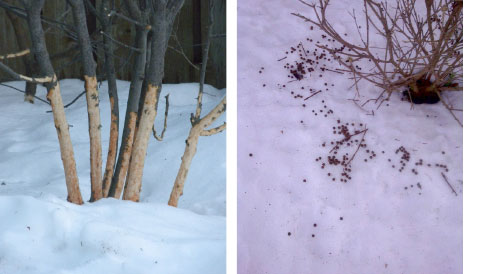|
There is a predator in our midst. Cute to some, the rabbit, to a dedicated gardener is enemy #1. In quick order, they can devastate a garden by mowing down shrubs and perennials, seemingly overnight. Rabbit damage to landscape plants tends to be worse in years of colder winters with significant snow cover as many other food sources run out. As the snow melts, the damage they have done to our favorite ornamental trees, shrubs and perennials becomes apparent with more to come once plants start sprouting new growth Plants often recover from rabbit foraging, however, if the damage is severe as is experienced after a cold, snowy winter, then it may be too late.
Look for the signs. Rabbit damage looks like someone was busy with the pruners. Each branch or shoot is cut cleanly at a forty-five degree angle by their powerful incisors. Rabbits also tend to gnaw the smooth, thin bark from young trees while the tough, thick bark of older trees is too difficult to chew through. Gnawing can completely girdle, or remove a ring of outer and inner bark from, a tree. Rabbits generally feed no more than two feet above the ground or at snow level but in a year of significant amount of snow coverage, you may see damage to higher branches.
 Damage by rabbits is often concentrated in areas near escape cover. If food and other necessary resources are available in one place, rabbits won’t move about too much. If their food source and area for shelter are separated, they will move between these areas in the morning and evening. Their travels are habitually made on the same trails every day, producing noticeable paths through herbaceous vegetation. You will notice their tracks as well as their scat, small pea-like, flat pellets. Damage by rabbits is often concentrated in areas near escape cover. If food and other necessary resources are available in one place, rabbits won’t move about too much. If their food source and area for shelter are separated, they will move between these areas in the morning and evening. Their travels are habitually made on the same trails every day, producing noticeable paths through herbaceous vegetation. You will notice their tracks as well as their scat, small pea-like, flat pellets.
Feeding usually begins during the evening hours and continues throughout the night into the early morning. Their food habits vary, depending on location and the availability of appropriate plants. One needs to be aware of which plants rabbits like to munch on. They prefer to eat succulent, green vegetation; with grasses and herbaceous perennials and shrubs making up the bulk of their diet. In general, rabbits will avoid any plant that has a lot of sap or a lot of scent. There are lists of plants that are typically rabbit resistant (see below), but no list is fool proof—a hungry animal will eat just about anything.
- Trees and shrubs – Alder, birch, boxwood, red-twig dogwood, cotoneaster, hydrangea, St. Johnswort, holly, privet, mockorange, large rhododendrons, spiny roses, elderberry, lilac, spirea and yew.
- Perennials – Vinca, columbine, spurge, daylily, daffodils, solomon's seal and sedum.
Source: http://web.extension.illinois.edu/cfiv/homeowners/971227.html
Prevention is key to managing rabbits. Beyond installing plants that are ‘rabbit-resistant’, which again depends on the scarcity of food, there are a few methods that you can use to reduce the effects of rabbits in your garden. If you have a fence around the perimeter of your property, check for entry points to determine where and how rabbits are getting into the garden. If an opening is big enough for a small rabbit to fit through, block it! The presence of a dog in your garden area also helps deter rabbits. But if you go away for a week or two and there is an opening, they’ll do quite a bit of damage while you, and the dog, are gone.
Rabbit fencing can be installed around plants that rabbits prefer, but it needs to be at least 2 ½’ tall and buried 6’ below grade. This may be difficult to do and quite unsightly, but it usually does the trick.
If fencing cannot be installed or is not effective, then repellants need to be used. Scent repellents are usually a viable option but they need to be reapplied after rain or extended periods of time. (Refer to the label for complete instruction.) It is highly recommended to rotate several different repellents to minimize the chance that the animals will get used to a particular scent or taste. This will help to break their habits. A word of caution, the repellants smell horrible so pay careful attention to the direction of the wind and spray the repellent away from you with the wind to your back.
And lastly, rabbit control is a must before their spring litters are born, which starts in March and lasts through September. Rabbits can bear two to six litters a year, with the average litter size of 3 to 5 young. The adult rabbits may move onto a new landscape to seek their preferred food source, but their babies tend to remain in their area where they were born. Don’t delay, look for nests in your garden now and ‘evict’ the adults before the breeding and birthing season starts.
Sources used for this article:
http://www.ianrpubs.unl.edu/pages/publicationD.jsp?publicationId=1293
http://web.extension.illinois.edu/dmp/palette/090802.html
Download and Print this article here. |

